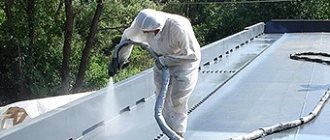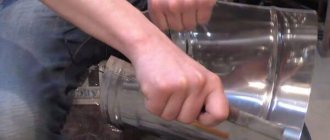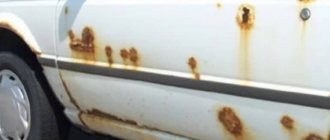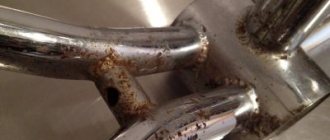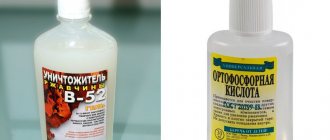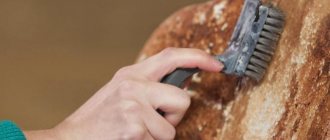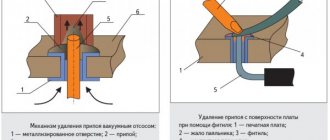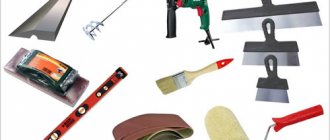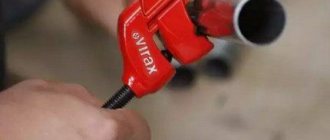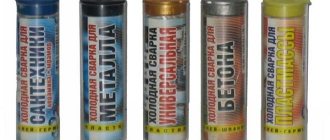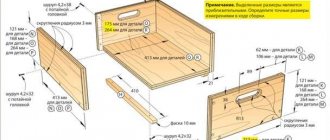by Alexey | Cleaning Tools | Friday, December 03, 2021
| Follow Make-Self.net on Facebook and be the first to read our articles. |
Rust is completely preventable, but it is often unavoidable if you have a large number of metal tools. Those tools that you left outside in the rain and snow are now unusable, but that doesn't mean you have to throw them away! There are several different methods you can use to clean rusty tools so they are ready for use.
Why do tools rust?
You want to clean rusty tools, but it's also important to understand how it happened in the first place. Rusty tools are the result of water remaining on the steel for a long period of time. Rust forms when oxygen and water react with iron . If a tool is constantly exposed to water and oxygen, rust can form within four or five days. If by the time you realize that your tools are rusty, corrosion has not yet set in (that's when holes start to form in the metal), you can still fix the situation by cleaning the rust off.
When it comes to removing rust, you have several options. Find out the best tips for removing rust from tools!
How and with what to properly clean metal tools
Tools damaged by rust cannot be used.
For large objects, a mechanical method is used, for example, sandpaper, a wire brush, a scraper or sandblasting.
This processing method is not suitable for small parts. In these cases, it is recommended to use store-bought cleaning products and folk recipes. Special compounds allow you to remove plaque without damaging the surface.
Before you clean rust on metal, you should prepare your tools for processing. If they are severely damaged by corrosion, you will need a steel wool brush for the procedure. For deep damage over a large area, it is recommended to use an electric grinder.
Metal cleaning devices require the use of physical force. In this case, care must be taken not to damage the surface structure. At the end of the work, you need to sand the tools with sandpaper to remove any traces of scratches.
Cleaning with sandpaper
When using sandpaper to remove rust, you will need a little bit of effort, as well as coarse and fine grit sandpaper. Start by cleaning the tool of dirt and grease, then dry it completely . Once it's dry, take some coarse sandpaper and sand off any rust from the surface , then switch to a finer grit so you can smooth out any grooves or marks left by the coarse sandpaper. If sandpaper doesn't help remove deeper rust, you'll have to double down on one of the other methods for removing rust from tools.
Rust removers
The most affordable professional way to remove corrosion from tools is through various solvents, cleaners and rust converters. They are present in huge quantities on the domestic market, and prices for such products start from several tens of rubles.
Unfortunately, among them there are quite a lot of low-quality items that can only remove surface corrosion. Therefore, before purchasing a specific product, I strongly recommend that you study reviews and reviews of it.
To summarize, I would like to note that it is much easier to prevent corrosion than to later solve the problems caused by its occurrence. To do this, do not forget to dry the tool after use (especially important for gardening tools) and store it in suitable places.
WD-40 and steel wool
WD-40 is a product specifically formulated to break the bonds between rust and the metal surface to which it is bonded. When you are trying to remove light surface rust from your tools, spray it directly onto the rusty area and let it sit for ten minutes . Once you've allowed the WD-40 to loosen the rust, take a piece of steel wool and scrape away the rust until the tool is clean. Wash the tool and dry it thoroughly before putting it back in the toolbox.
Folk remedies
You can quickly and safely deal with rust using available tools. The most unexpected and inexpensive compounds come to the rescue, including acetic acid, hydrogen peroxide and even carbonated drinks like Coca-Cola, but for these products to work, they must be used according to the instructions.
How to remove with acetic acid?
For cleaning, it is recommended to use an essence with a concentration of 70%.
Mode of application:
- Place the instrument that needs cleaning into a suitable container.
- Fill it completely with acetic acid.
- Cover the container with a lid and leave for several days. The more rust, the longer it will take.
- After cleaning, rinse the tool in a baking soda solution. It neutralizes acid.
After this treatment, you can continue to use the devices. The effectiveness of cleaning with essence is very high. It allows you to cope even with a thick layer of rust. If it is small, then you can use table vinegar or lemon juice.
It is not recommended to use vinegar to clean aluminum tools as it will dissolve the epoxy layer and damage the metal structure.
If rust has stuck to the tool in pieces, then the areas can be cleaned with ordinary food foil. It is used as a scraper.
Citric acid and hydrogen peroxide
You can get rid of rust using citric acid and pharmacy hydrogen peroxide. To prepare the solution you will need:
- citric acid – 20 g;
- peroxide – 15 ml;
- water – 100 ml.
Instructions for use:
- All components are mixed with each other.
- Place the instrument in a suitable container and fill it with solution.
- Leave them for a day under a closed lid.
- After the specified time, the solution is drained. The instrument is washed with clean water, dried and used for its intended purpose.
During the cleaning process, the solution will become dark in color. This is normal and indicates the effectiveness of the composition. With its help you can cope with a small layer of rust.
If the instrument is severely damaged, the concentration of the solution must be increased. In advanced cases, they refuse to add water altogether, dissolving citric acid in peroxide .
The video will tell you how to remove rust using citric acid and peroxide:
How to remove Coca-Cola?
Coca-Cola is a popular carbonated drink that can be used to remove rust. The effect is achieved due to the content of orthophosphoric acid, which corrodes oxides.
Mode of application:
- pour Coca-Cola into a suitable container;
- place rusted objects in it;
- cover the container with a lid;
- leave for a day.
The next day, the part is removed, rinsed with clean water and dried.
Coca-Cola is one of the budget and effective rust removers. Sprite and Fanta have a similar effect.
Soda
You can deal with rust using baking soda. An alkaline solution will help get rid of a small layer of corrosion without harming the metal. The effectiveness of the method is explained by the active action of sodium.
Mode of application:
Prepare the required amount of soda slurry by mixing the powder with water. It should be moderately thick, reminiscent of a paste in consistency.- Using a sponge, apply the paste to the instrument.
- Leave the mixture to act for an hour.
- Rinse the product and wipe it with a dry soft cloth.
- If necessary, the procedure can be repeated.
Baking soda is not a highly effective way to combat rust, but a small layer can be removed this way.
Zinc chloride
You can use zinc chloride to remove rust. Apply it as follows:
- 20 g of zinc chloride are dissolved in 200 ml of water, the product is prepared in the quantity required;
- pour the solution into a suitable container, lower the tool into it;
- leave to act for an hour;
- Rinse the instrument with clean water and wipe with a dry cloth.
Zinc chloride contains free hydrochloric acid, which has the ability to dissolve rust. The main thing is not to overexpose the composition so that the metal itself does not turn black.
The method is quite effective; zinc chloride can cope with even large areas of corrosion.
White vinegar
White vinegar is just what you need to remove those stubborn patches of rust that you can't seem to remove with other methods. Acetic acid will help break down rust. To get the most out of vinegar on your tools, you need to completely immerse them in water. For small items like wrenches, you can submerge them in a small bowl, but larger tools will require a bucket or large container. Leave the tools in the vinegar overnight. At a minimum, you should wait at least six hours.
A mixture of vinegar and lemon juice
The “classic” rust remover is a solution of vinegar and lemon juice, which are mixed in equal proportions.
- The resulting mixture is applied to the damaged areas of the instrument using a sponge or soft swab.
- After treatment, the tool is left for a couple of hours so that the product has time to remove the rust. It is important to ensure that the applied solution does not dry out, and to do this, periodically apply the product to previously treated areas.
- After a couple of hours, the remaining mixture should be rinsed off under running water and then the instrument should be dried.
Note! When using this method, it is important to follow safety rules, use gloves, and protect mucous and wound surfaces!
Oxalic acid
Oxalic acid is a chemical-based solution that will attack areas of rust that you couldn't remove with sandpaper or vinegar. When working with oxalic acid, make sure you wear appropriate protective clothing and always read the label instructions carefully.
Degrease and clean the tools, dry them thoroughly, and then place them in large containers filled with 5 liters of water. For best results, store each tool in a separate container. Add three tablespoons of oxalic acid to the water , mix thoroughly and let the solution soak for up to 20 minutes. After soaking, you can wash off the softened rust and oxalic acid residues.
Potato
It may seem strange, but even ordinary new potatoes are suitable for removing rust. To do this, the potato tuber is cut in half, and one of the halves, which will be used in the work, is sprinkled with salt. The latter is necessary in order to draw moisture to the cut, as well as to give the potato surface abrasive properties.
After cooking, the damaged area is generously rubbed with potatoes and left in this form for 15-20 minutes. At the end of the period, the instrument is wiped and dried. This method is suitable for removing surface rust that has not yet penetrated deep into the metal.
What to do if the hinge is rusty
If your tool's hinge is rusty but the outside is not, you'll want to take a different approach. Instead of soaking your entire tool in vinegar or trying to scrub it off with steel wool, you'll need an all-purpose oil that serves to clean and lubricate your tools. Apply a small amount of oil to a rag and wipe the rusted hinge . You can also drop a small amount of oil directly onto the assembly while moving the tool back and forth. Once the oil has become a slurry, take a clean rag and wipe off the excess oil. Repeat the process until the tool's hinge works properly again.
Rust converters for tools
ASTROhim Antiruster is one of the most effective rust converters.
There are products on sale that allow you to stop the oxidation process - these are rust converters, which are available in the form of an aerosol. They are usually used as a primer for painting. Such compositions are made on the basis of orthophosphoric acid. The most common: Fenom, Permatex, ABRO, ASTROhim Antiruster .
These preparations are recommended for use when you plan to coat metal products with paint. They do not remove rust, but only stop the corrosion process.
The advantage of converters is that after they are applied, a special film appears on the surface, protecting against further spread of plaque.
How to prevent rust
Controlling humidity and keeping your tools away from water is key to preventing rust. To prevent tools from rusting over time, store them in a dry place. If any of your instruments get wet (rain, snow, etc.), dry them as thoroughly as possible and as soon as possible . It's also best to store all your tools (including power tools) off the ground, especially if they're stored in a workshop or garage, so there's no risk of moisture seeping through the floor.
Sealing the metal parts that are most susceptible to moisture is also a reliable rust protection tactic. Most manufacturers provide a layer of chrome or paint, but older tools often do not have a protective coating. Paint, rubber sealant or wax coating are cost-effective ways to prevent rust and extend the life of your tools.
Follow us on Pinterest for more interesting articles.
Useful short videos from Make-Self.net
How to clean rusty tools at home
It is much easier to clean a metalwork tool from rust than a manicure tool, since it does not have decorative elements.
Electrolysis: step-by-step instructions
The most effective way to clean rust from iron tools is electrolysis. Advantages of this method:
- You can remove rust from even the thinnest parts, such as the edges of cutting surfaces, without dulling them or damaging the engraving. During electrolysis, iron that has not undergone oxidation is not affected.
- Rust easily disappears even from the most inaccessible places that cannot be reached mechanically.
- The instrument is cleaned without physical effort at the molecular level.
- No cost required.
In order to carry out the reaction, you need to prepare the following:
- A small plastic or ceramic container the size of the instrument. If you take a metal one, the reaction will not work, and too large a volume will cause the process to slow down and require more power from the current source.
- Copper wire and 2 wires.
- A current source, preferably with adjustable voltage and specified poles at the terminals.
- Caustic or soda ash (not to be confused with baking soda: these are different substances).
- Unnecessary piece of iron, to which iron oxide and salt deposits from the necessary parts will be transferred. You can even use stainless steel for this purpose, but it will release more harmful substances during electrolysis.
Cleaning should be done in a well-ventilated area or outdoors, especially if stainless steel is used in the process, as hydrogen will be released, which not only smells unpleasant, but is also toxic and explosive. The process itself is carried out as follows:
- The tool to be cleaned is tied into one chain with wire. It is very important that there is good contact.
- A wire with rusty parts is attached to one wire, and a metal receiver to the other. Here it is important not to confuse and connect the desired material to the cathode, that is, the minus, and the electrode to the plus. If you mix it up, you can completely ruin the instrument.
- The entire structure is placed in a non-metallic container that does not allow electric current to pass through, and is filled with an alkaline solution at the rate of approximately 2 tablespoons of soda ash per liter of water. Knowledgeable people recommend different amounts of soda, so it’s better to experiment first and find your own dose.
- Next, the current is started. In this case, the liquid begins to actively boil, and bubbles are released from the surface of the parts. If the current is weak, the reaction will take a very long time, but too strong can lead to a sudden release of toxic substances and violent boiling.
Complete cleaning usually occurs within a few hours, depending on the size of the tool, the depth of the corrosion and the intensity of the reaction. If the salt transition rate is low, you can leave it overnight.
After the procedure, carbon deposits may remain on the iron. It can be easily removed by boiling the cleaned instrument in water with the addition of citric or acetic acid.
A 10% solution of hydrochloric or sulfuric acid will also help remove rust from metalworking tools.
Manicure and hairdressing tools
Rust on manicure or hairdressing tools usually forms a small layer. It is best to remove it using a phosphoric acid-based rust converter, which will not only eat the oxides, but also cover the surface with a protective layer that is resistant not only to oxygen, but also to other chemical reactions.
Then you can use more expensive specialized tools, for example, Sphere Instrum.
If it is not possible to look for specialized products in stores, then you can simply remove rust from a manicure tool by boiling it in Coca-Cola or other soda containing phosphoric acid (Cola, Sprite, Pepsi).
Preventing rust
High humidity, temperature changes, and aggressive environmental influences always lead to the formation of corrosion on metal products. For prevention, you must adhere to several rules:
- The instrument should be wiped down after each use. Shovels, rakes and other gardening tools should be cleaned with solvent or kerosene to completely remove residues and plant juices.
- Regularly treat metal objects with special compounds that prevent corrosion.
- Periodically carefully inspect all instruments for damage. Replace damaged parts immediately. At the first sign of rusting, take action immediately.
Particular attention should be paid to those places that are located near the fasteners or blades. They must be cleaned with a stiff wire brush and plain water.
There is no need to throw away an old tool that is covered in rust. There are special products on sale that can restore it to its original appearance and eliminate signs of corrosion. For this purpose, you can also use substances that are always at hand. Getting rid of rust will not take much time, and the service life of the tools will be significantly extended.
Pros and cons of deletion
Using vinegar to combat rust stains, you can appreciate a number of positive aspects:
- The versatility of the product (vinegar solution perfectly removes red stains from metal, plastic and ceramics).
- Availability (low cost, vinegar solution is available in any kitchen).
- Efficiency (at a pH of 2.5 pH, the vinegar solution dissolves stubborn stains of rust, grease and lime in a matter of minutes).
The downside to using a vinegar solution to remove rust stains is that it has a pungent odor.
An open window in the room and a few drops of your favorite essential oil, previously added to the cleaning solution, will help solve the problem of unpleasant odor.
Formation of rust on metal
The process of the appearance and development of rust on metal structures begins due to the appearance of an oxidative chemical reaction under the influence of strong dampness. The formation of corrosion is accompanied by deformation of the metal surface and destruction of the crystal lattice. There are several causes of iron rusting:
- Paint chips. The surface of many metal structures is covered with a protective layer of paint, which prevents moisture from contacting the iron. However, over time, the paint begins to peel off the product, which leads to corrosion.
- Scratches. Rusting of iron is facilitated by deep cracks on the surface.
- No anti-corrosion treatment. Experts advise treating metal with special anti-corrosion agents. If this is not done, the iron will gradually begin to become covered with a rusty coating.
Methods for preventing corrosion in industry
Galvanization
How do you remove rust in production? Galvanization is often used. A zinc layer is applied to the product. Zinc is inexpensive and has excellent adhesion to steel. In more aggressive conditions it is better to use cadmium. Aluminum is often used today. It migrates into the coating, covers scratches, and provides long-lasting protection.
Cathodic protection
How do you remove rust from metal, other than galvanization? Cathodic protection is considered a method that is used to prevent corrosion processes in underground/water-borne structures by means of an electrical charge that suppresses electrochemical reactions. The sacrificial anode must be made of a material having an electrode potential that is more negative than that of iron/steel.
